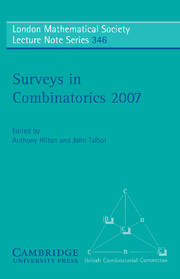Book contents
- Frontmatter
- Contents
- Preface
- 1 Hereditary and monotone properties of combinatorial structures
- 2 Ordering classes of matrices of 0's and 1's
- 3 Cycle decompositions of complete graphs
- 4 Excluding induced subgraphs
- 5 Designs and topology
- 6 The number of points on an algebraic curve over a finite field
- 7 On the efficient approximability of constraint satisfaction problems
- 8 The combinatorics of cryptographic key establishment
- 9 Bandwidth of graphic matroids
8 - The combinatorics of cryptographic key establishment
Published online by Cambridge University Press: 16 March 2010
- Frontmatter
- Contents
- Preface
- 1 Hereditary and monotone properties of combinatorial structures
- 2 Ordering classes of matrices of 0's and 1's
- 3 Cycle decompositions of complete graphs
- 4 Excluding induced subgraphs
- 5 Designs and topology
- 6 The number of points on an algebraic curve over a finite field
- 7 On the efficient approximability of constraint satisfaction problems
- 8 The combinatorics of cryptographic key establishment
- 9 Bandwidth of graphic matroids
Summary
Abstract
One of the most important processes involved in securing a cryptographic system is establishing the keys on which the system will rely. In this article we review the significant contribution of combinatorial mathematics to the development of the theory of cryptographic key establishment. We will describe relevant applications, review current research and, where appropriate, identify areas where further research is required.
Introduction
Cryptography provides the core information security services that are necessary to safeguard electronic communications. The sound management of cryptographic keys is the fundamental supporting activity that underpins the secure implementation of cryptography. The purpose of this paper is to demonstrate the significant contribution of combinatorial mathematics to the development of the theory of cryptographic key establishment.
Scope: This paper surveys areas of key establishment where combinatorial models or construction techniques have proven of value. Our aim is not to provide a comprehensive survey of the literature, but rather to provide sufficient coverage that most relevant work will be (to use the terminology of Section 7.3.3) at most a “two-hop path” from this review. This paper is not an attempt to survey the vast research on key establishment in general.
Detail: The primary aim is to bring these applications of combinatorics to the attention of the mathematical community within a sensible unifying framework. We thus focus on introducing concepts and providing pointers for further study. This paper contains no proofs. Combinatorial modelling typically involves the establishment of bounds and constructions. For illustrative purposes we will tend to focus on constructions in this review.
[…]
- Type
- Chapter
- Information
- Surveys in Combinatorics 2007 , pp. 223 - 274Publisher: Cambridge University PressPrint publication year: 2007
- 3
- Cited by



